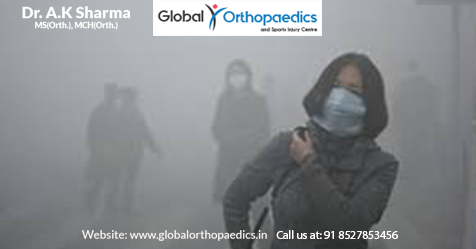The WHO has ranked air pollution as one of top 10 preventable causes of
death. In fact it has predicted that by 2020 there will be 8 million deaths
per year due to air pollutants. Some people are more sensitive to the
effects of smog and air pollution than others, including those with existing
chest, lung or heart complaints. populations that are particularly at risk
include:
• people with asthma
• people with heart disease
• people with respiratory diseases
• children
• active adults who exercise outdoors
• older adults
• people with diabetes
• pregnant women

The first health signs of smog may be irritation in the throat, nose, eyes or lungs and breathing may be affected. Practical steps to protect yourself -If you have respiratory problems and are affected by smog and air pollution, or are keen to protect yourself or your children from potential health effects, there are practical steps you can take.
Be Informed- Simply knowing air quality is not sufficient. Before going outside, physicians recommend patients check the air quality.
Protect your home- work with your family to prevent any exposure to secondhand smoke. Often neighbors or family members smoke in the hallways or just outside of apartment buildings. But this air still comes into the partments and harms the vulnerable groups inside. Without effective airtight seals on doors/windows, the poor air from outside still comes inside.
There are some steps that can be taken to protect the lungs once outside.
• First of all, do not engage in strenuous activity such as jogging
if the (AIR QUALITY INDEX) AQI is high.
• Secondly, limit your time outside if possible.
• The third (and most frustrating step for health professionals)
relates to masks.
Fortunately, there are some masks that are proven repeatedly in studies to minimize outdoor exposure to fine particulate pollution. These are so-called N95 respirator masks that are usually reserved for high-risk occupational material exposure. They receive their name based on the percent of fine particulates they filter out.
The US Food and Drug Administration (FDA) has approved the 3M Particulate Respirator 8670F/8612F or the Pasture F550G/A520G Respirator- proven respirator masks by US guidelines. In short, the effectiveness of these masks is controversial, and in many cases they do nothing at all, so before spending money on any mask found in a store or online, check to see that there is independent testing done to prove its effectiveness.
• If the air quality forecast is poor, stay indoors and keep your windows closed – or, where possible, avoid the affected areas.
• You can add more charm to your house decor and simultaneously reduce indoor pollution by bringing in air-purifying plants like Peace Lily, Florist’s Chrysanthemum, Golden Pothos, and English Ivy.
• Smokers are at an increased risk of chest infections in polluted areas – try to quit or at least cut down.
• Stock up on foods high in antioxidants, like cherries, kale, and tomatoes. Antioxidants trap free radicals, which help pollutants do their dirty work in the body.
• Avoid exercising in smoggy conditions, particularly at midday when ground ozone levels are at their highest.
• If you’re asthmatic or have COPD (chronic obstructive pulmonary disease), carry inhalers at all times. If smog is bad, treatment may need to be increased for a while. If you notice any rapid deterioration in your condition, consult your doctor.
• If you have respiratory conditions and need to travel on smoggy days, avoid congested areas where you may get stuck in traffic jams. Road junctions can be a hotbed of exhaust emissions. Keep your windows closed.
• If you’re walking or cycling to work, plan a route that avoids too many areas that are built up or congested with cars.
• Keep your own emissions to a minimum. Avoid unnecessary car journeys in cities, don’t rev up or leave your engine running for a long time outside your home on cold days or when stuck in traffic jams.


